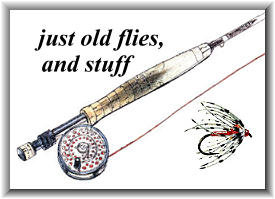William B. Mershon, born in 1856 and an early lumberman in Michigan,
is the man after whom this fly was named. He fished the streams of
Michigan when they were filled with graying, when streams had fish
and fishermen were few.
He is the author of Passenger Pigeon 1907, and
Recollections of My Fifty Years Of Hunting and Fishing, 1923.
Mr. Mershon's home was in Saginaw, Michigan. [The Mershon Chapter
of Trout Unlimited, the first TU Chapter was named for him, in 1958.
Both JC and the LadyFisher were members of that chapter.]
As to the fly, I quote from a letter from Mr. Mershon to me, dated
February 10, 1942:
"The Mershon fly originated from the old Mowry, which was made of
a turkey wing, and it was, I though, not bright enough, so I wrote
to Wm. Mills & Son, New York, and asked them to tie some flies for
me with a black silk body and wings feathers from a mallard drake,
leaving the tip of white thereon. They did so, and afterwards I had
Mills have some tied with a white body, and the white bodied Mershon
proved to be more attractive than the black bodied. I used this
fly with great success on the Black River, many years ago.
George Morley and I were fishing that stream from our camp at what
we called 'Camp Higgins.' We'd been driven in from Vanderbilt
with horse and wagon. George King was our driver and pilot.
The getting in and getting out places were familiar to him
and we knew nothing about the stream. It was wonderful brook
trout fishing. George and I made a 10" limit that day and we
had what was legally allowed, by midafternoon - fifty fish each.
I remember I had one brook trout 16" long in the basket. We
had brought a lot of ice, so by taking good care of our fish
we were able to bring them home. Later on, a logging railroad
was built in to the Black River and we used to go up there with
the old private car 'Mershon,' with a party of a half dozen,
and spend several days. In 1903 I took the last grayling that
I ever got from that stream. That was the end of this grand
fish - the Michigan grayling.
My favorite trout stream was the North Branch of the Au Sable,
where I began fishing fifty years ago. It was the greatest
trout stream in the world, and still would be if it had not
been allowed by the power that be to fill up with silt. This
silt used to be swept out in the old lumber days by the flooding
from Dam 3, which occurred, during the summer, several times a
week. The water would rise fully two feet, down as far as
Lovell's and it swept this silt before it and left the spawning
beds clean. There is no caddis fly hatch there, any more. As
all the old logs and roots are buried, there is no place for
the attachment of the shell of the larvae."
Mr. Mershon was secretary of the Michigan Sportsmen's Association in 1882."
Mershon (White)
As tied by Ray Bergman
- Tail: Golden pheasant.
- Body: White silk.
- Hackle: Light brown.
- Wing: Dark Blue, white-tip.
Mershon (Black)
As tied by Ray Bergman
- Tail: Black.
- Body: Black silk floss.
- Hackle: Black.
- Wing: Dark Blue, white-tip.
Credits: Information and recipe from Fly Patterns and
Their Origins, by Harold Hinsdill Smedley, photos from Forgotten Flies.
|

